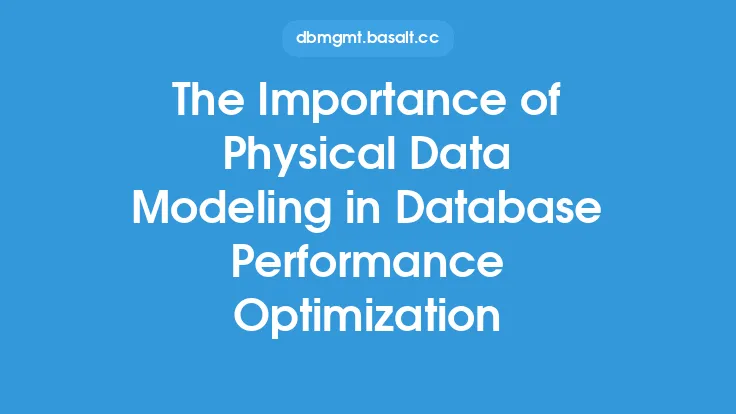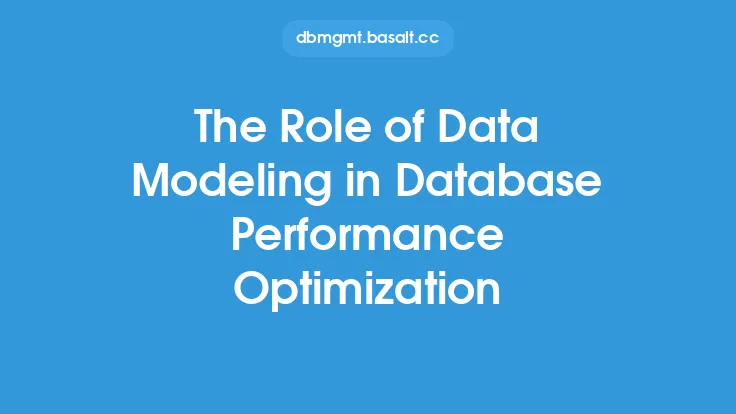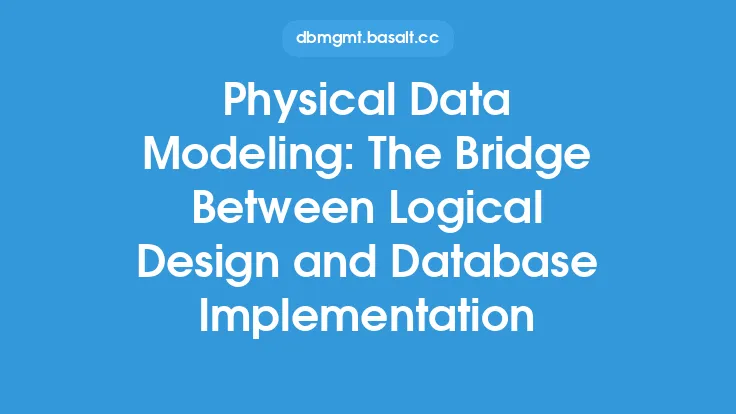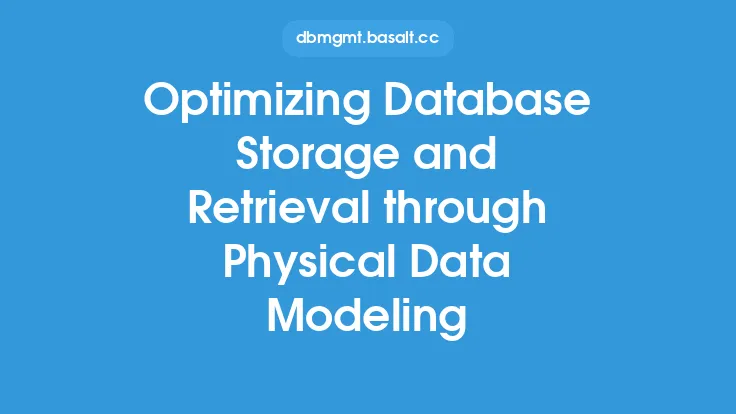Logical data modeling is a crucial step in the database design process, as it enables organizations to create a conceptual representation of their data assets. This process involves identifying entities, attributes, and relationships, and organizing them into a logical structure that can be used to support business operations. One of the key benefits of logical data modeling is its ability to improve database performance optimization. By creating a well-designed logical data model, organizations can ensure that their databases are optimized for query performance, data storage, and data retrieval.
Introduction to Database Performance Optimization
Database performance optimization is the process of improving the speed and efficiency of database operations, such as query execution, data insertion, and data retrieval. This is achieved by identifying and addressing performance bottlenecks, such as slow-running queries, inadequate indexing, and inefficient data storage. Database performance optimization is critical in today's fast-paced business environment, where organizations rely on databases to support their operations and make informed decisions. A well-optimized database can improve business productivity, reduce costs, and enhance customer satisfaction.
The Role of Logical Data Modeling in Database Performance Optimization
Logical data modeling plays a critical role in database performance optimization, as it enables organizations to create a database design that is optimized for performance. A well-designed logical data model can help to improve query performance, reduce data redundancy, and enhance data integrity. By identifying entities, attributes, and relationships, organizations can create a logical structure that supports efficient data storage and retrieval. Additionally, logical data modeling can help to identify performance bottlenecks, such as slow-running queries, and provide opportunities for optimization.
Key Principles of Logical Data Modeling for Database Performance Optimization
There are several key principles of logical data modeling that can help to improve database performance optimization. These include:
- Data normalization: Data normalization is the process of organizing data into a logical structure that minimizes data redundancy and improves data integrity. Normalization can help to improve query performance, reduce data storage requirements, and enhance data security.
- Indexing: Indexing is the process of creating data structures that improve query performance. Indexes can be created on columns or tables, and can help to speed up query execution.
- Denormalization: Denormalization is the process of intentionally violating data normalization rules to improve query performance. Denormalization can be used to improve query performance, but can also lead to data inconsistencies and errors.
- Data partitioning: Data partitioning is the process of dividing large datasets into smaller, more manageable pieces. Partitioning can help to improve query performance, reduce data storage requirements, and enhance data security.
Best Practices for Logical Data Modeling and Database Performance Optimization
There are several best practices that organizations can follow to ensure that their logical data models are optimized for database performance. These include:
- Use a structured approach: A structured approach to logical data modeling can help to ensure that the database design is optimized for performance. This includes using a standardized methodology, such as the Entity-Relationship model, and following established best practices.
- Use data modeling tools: Data modeling tools, such as entity-relationship diagrams (ERDs) and data flow diagrams (DFDs), can help to create a visual representation of the database design. These tools can help to identify performance bottlenecks and provide opportunities for optimization.
- Test and refine: Testing and refining the logical data model can help to ensure that it is optimized for performance. This includes testing the database design with sample data, refining the design based on performance metrics, and iterating on the design until it meets performance requirements.
- Monitor and maintain: Monitoring and maintaining the database design can help to ensure that it continues to meet performance requirements over time. This includes monitoring performance metrics, identifying performance bottlenecks, and refining the design as needed.
Common Challenges and Solutions
There are several common challenges that organizations may face when implementing logical data modeling and database performance optimization. These include:
- Data complexity: Complex data structures can make it difficult to optimize database performance. Solution: Use data modeling tools and techniques, such as data normalization and denormalization, to simplify the data structure and improve query performance.
- Data volume: Large datasets can make it difficult to optimize database performance. Solution: Use data partitioning and indexing to improve query performance and reduce data storage requirements.
- Data security: Ensuring data security can be a challenge, particularly in regulated industries. Solution: Use data encryption, access controls, and auditing to ensure that data is secure and compliant with regulatory requirements.
Conclusion
Logical data modeling is a critical step in the database design process, as it enables organizations to create a conceptual representation of their data assets. By creating a well-designed logical data model, organizations can ensure that their databases are optimized for query performance, data storage, and data retrieval. By following best practices, such as using a structured approach, data modeling tools, and testing and refining the design, organizations can create a logical data model that is optimized for database performance optimization. Additionally, by monitoring and maintaining the database design, organizations can ensure that it continues to meet performance requirements over time.





